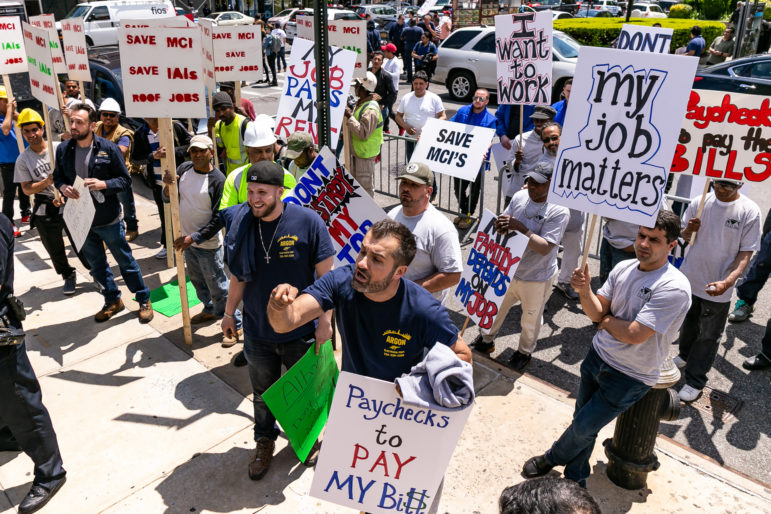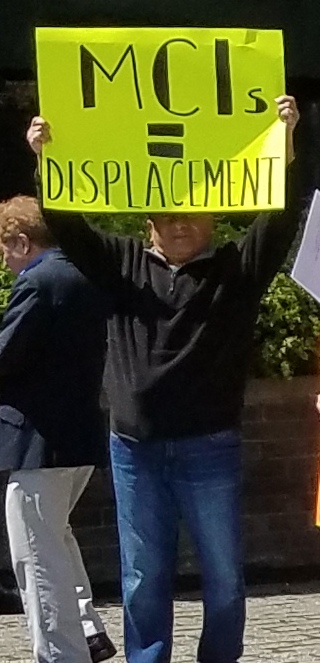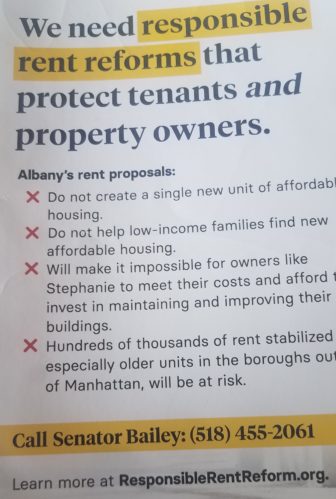
Adi Talwar
Contractors squared off with tenants and their allies outside a hearing about rent regulations on May 16 at Medgar Evers College in Brooklyn.
The year was 1985. Then as now, change was looming over the rules allowing owners of regulated New York City apartments to impose extra rent hikes by citing the cost of major capital improvements. The restrictions being contemplated had one prominent property owner ready to leave the multifamily sector entirely. “Rental housing is tomorrow’s dinosaur,” the owner, Herman Kraus, told the New York Times.
The dreaded changes went through: Landlords were allowed to boost rents only 6 percent to cover new capital costs, not the previous 15 percent.
Somehow, in the 34 years since, rental housing avoided going the way of the Triceratops.
The rules covering major capital improvements, or MCIs, are again in the spotlight as tenant advocates press the Democrat-controlled state legislature for sweeping changes to the rent regulations covering nearly a million New York City apartments and thousands of homes in surrounding counties.
Landlords and their allies, almost certain to lose some of the tools they now use to raise rents and deregulate apartments, are fighting fiercely to protect MCIs and individual apartment increases, or IAIs.
Last month landlord groups helped organize a demonstration by building contractors—who say their earnings depend on MCI and IAI work—outside a Senate housing committee hearing in Brooklyn.
The argument is also finding its way into mailboxes. “Albany wants to gut programs that let owners maintain these buildings. We need responsible rent reforms that protect tenants and owners,” read a mailer sent out last month by a pro-landlord group. “Without them, they’ll make it impossible for many owners to afford to maintain their buildings, causing them to fall into disrepair.”
Indeed, the real-estate industry seems to be straining to maintain the sense of impending crisis: In a statement this week about its quarterly business confidence survey, the Real Estate Board of New York highlighted concerns over “Albany’s proposed rent reforms”–even as it reported rising optimism across all sectors.
The predictions of a maintenance calamity seem, at the very least, overstated. After all, MCIs are not supposed to cover routine maintenance of buildings. And while housing conditions have largely improved, there are still plenty of rent-stabilized buildings that, even with access to MCIs, fall short of providing decent conditions for tenants.
Still, some housing experts have cautioned about ending a source of financing for building improvements. Indeed, the real-estate sector’s full-court press has obscured the fact that, of all the elements of the rent law that are targeted for possible change this year, MCIs are the most complicated. Policymakers have for decades been trying to balance the need to permit investment to preserve housing with their mandate to maintain the modest, regular rent hikes that are the raison d’etre of the stabilization system. This year could be their best chance ever to get it right.
Long list of reforms sought
The rent-stabilization laws apply to the five boroughs and Nassau, Rockland and Westchester counties. In the city, they reflect the combined impact of a 1969 city statute—the Rent Stabilization Law—and a 1974 state measure, the Emergency Tenant Protection Act. Both laws have been altered over subsequent years by amendments and renewals, and their interpretation has been shaped by court decisions, too.
There are now around 966,000 rent-stabilized apartments in New York City—a portfolio comprised of buildings constructed before 1974 and newer structures whose owners agreed to stabilization in exchange for tax breaks or other subsidies.
Rents on stabilized units in the city cannot be raised more than the amount set each year by the Rent Guidelines Board, whose nine members are all appointed by the mayor and which, by statute, is supposed to base its rent-hike decisions on a balance of affordability for tenants and “fair returns” for owners.
While the RGB sets the ceilings on rent hikes, the other elements of the system are controlled by state policy, and a hefty menu of bills that would change aspects of that system is on the docket in Albany as the June 15 expiration date for the current law approaches.
One measure would expand the stabilization system to other counties in the state, and a second would impose a “good cause” eviction law for all renters, even those in buildings with fewer than six units that aren’t covered by rent stabilization. A third bill deals with vacancy decontrol – a mechanism that takes apartments out of the stabilization system once their rent crosses a threshold and they go vacant—while another proposal would create a longer statute of limitations for tenants to lodge an overcharge complaint against their landlord.
Get the best of City Limits news in your inbox.
Select any of our free weekly newsletters and stay informed on the latest policy-focused, independent news.
The remaining four bills all deal with ways landlords raise rents beyond what is permitted each year by the RGB. One is the vacancy bonus, which permits up to a 20 percent boost in rent upon vacancy. Advocates want to get rid of that. Another is preferential rents, which are discounts offered by landlords when the legal rent on an apartment is more than the market can bear, and which under current law the landlord can withdraw suddenly, leading to dramatic jumps in rent. That’s also on the chopping block.
Then there are IAIs and MCIs. The bills tenant advocates are pushing would ban both.
How IAIs and MCIs work
Rent increases for individual apartment improvements, or IAIs, almost always happen when an apartment is vacant. They’re supposed to occur “when there has been a substantial increase of dwelling space, an increase in the services provided by the owner, improvements installed in the housing accommodation, or new furniture or furnishings provided by the owner,” according to the state Division of Homes and Community Renewal, or DHCR, which administers the rent laws.
But an owner doesn’t need to apply for permission to do an IAI rent increase, or alert regulators that he’s imposing one, or tell the new tenant that their rent is higher because of it. There’s not even any official record-keeping of how many IAIs occur or how much landlords set out to recoup from them – though a report commissioned by the Rent Stabilization Association, the landlord lobby group, estimated IAIs totaled $130 million in capital improvements in 2014. While landlords are limited in how much of the IAI cost they can tack on to each apartment’s monthly bill, there’s no limit to the total cost on the “improvements” that can be amortized.
The total absence of oversight over IAI has generated increasing criticism. There’ve been reports of IAI fraud for years and, even when the claimed work does occur, the costs pose a serious challenge to the rent-stabilization system. In a recent report, the Association for Neighborhood and Housing Development, quoting data from rent histories that the Housing Rights Initiative had obtained, said that in buildings that had seen an IAI, the average rent jumped 107.5 percent.
“A review of available data shows the IAI system to be not only open to rampant fraud, but fundamentally designed and legally used to drive speculation and displacement,” ANHD contended. With vacancy decontrol , the sharp rise in rents triggered by IAIs not only means that apartments are significantly less affordable but also that they are edging ever closer to leaving the stabilization system.
Major capital improvements, on the other hand, affect both current and future tenants. They are supposed to be for building-wide improvements, like new roofs, boilers, windows, plumbing or electrical rewiring. Unlike IAIs, landlords do have to apply for MCIs and await approval. Landlords are allowed to increase rents to cover the cost of an MCI over 96 or 108 months, depending on building size. The increase in rent can’t be more than 6 percent year to year, but it’s permanent.
According to DHCR, the average wait time is 10 months for MCI approval. In 2018, the agency approved or partially approved 1,020 MCI applications “which represents over $200 million in capital investment in our rent-regulated housing stock,” according to the agency. It also turned down 107 applications – an approval rate of over 90 percent.
“The governor is fully committed to working with the legislature and tenant community to reform rent regulations, including ending vacancy decontrol, repealing preferential rent and limiting capital improvement charges to protect affordable housing and respect tenants’ rights,” writes a DHCR spokeswoman in an email to City Limits.
A contentious history
During the first 15 years of rent stabilization in New York City, landlords were allowed to amortize the cost of MCIs over five years, but then had to stop charging extra once they had recouped the cost of the capital work.
But then in 1984, the rent hikes were made permanent. Landlords’ argument was that, unless the rent jumped permanently, there would be no incentive for them to do the capital work: Why invest in something when you know you’ll just end up back where you started?
That year, 1984, is also when a city panel, the Conciliation and Appeals Board, gave the task of adjudicating MCIs over to DHCR. Complaints about a backlog of cases began to make the papers. But landlords soon had other complaints, like DHCR’s move to reduce impose a cap on MCI increases of 15 percent and then, the following year, to reduce that cap to 6 percent because of court action by tenants.
It was during this period that judges started dealing with court cases concerning key parts of the MCI system. One, Ansonia Residents Association v. DHCR, was filed in 1987 to challenge DHCR’s decision to allow permanent rent increases as a result of MCIs. In 1988, a state judge sided with tenants, ruling that under he existing policy, “tenants pay an increased rent-forever, and the landlord continues to extract a profit long after it has been fully reimbursed for the cost of the investment” and concluding “this policy violates both the specific requirements of the Rent Stabilization Law and its general purpose.” The case went all the way to the state’s highest court, which sided with landlords in 1989. Then in 1991, a judge ruled in a second case, Bryant Avenue Tenants Association v. Koch, that MCI, increases couldn’t be added to a tenant’s base rent. That was overturned in landlords’ favor in 1993—10 years after the case was filed.

A pro-reform protester gets arrested at a 2015 demo.
There was action during this period in Albany, too. In 1992, state law changed to stretch out the period over which an MCI cost is “amortized” from five years to seven years, effectively reducing the amount of MCI costs that could be tacked onto a tenant’s bill per month, but keeping the hikes permanent. The following year, landlords and developers beat back a bid to again make MCI charges temporary. State law swung decisively in landlords favor when rent regulations were renewed in 1993 and 1997, but there was little change in provisions affecting MCIs. Four years ago, Mayor de Blasio and Democrats in the Assembly and Senate pushed not to end MCIs but to, once again, make them temporary. That failed, but the amortization period was stretched from seven to eight years.
Now, with the rent regs up for renewal again, there are several proposals on the table. A bill by Sen. Michael Gianaris of Queens would eliminate MCIs altogether – that’s one of the nine bills tenant advocates support. A different approach by Sen. Jamaal Bailey of the Bronx/Westchester would make MCIs time-limited. Other measures would tweak time limits or how the application process works.
A shouting match
Outside the Senate hearing in Flatbush last month, tenants and contractors squared off, shouting at each other across a stretch of sidewalk in front of Medgar Evers College. The contractors held up signs that said things like “Save IAIs” and “MCIs Pay My Rent.” One of the contractors, an electrician, said he estimates that IAIs and MCIs comprise 50 to 60 percent of his work. He argued that tenants would regret denying landlords some inventive to update buildings beyond the minimal requirements imposed in city codes.
“If New York City says they don’t have to renovate, what are you going to do without an air-conditioner?” he asked. Speaking with City Limits, he said that tenants would use items like air conditioners even if the electrical systems in aging buildings weren’t equipped to handle them. “They’re just going to burn the building down. They’re going to break the plumbing. And who’s going to pay for it?”

Murphy
A tenant protester outside the May 16 hearing.
Statistics indicate that most rent-stabilized apartments—about 85 percent of them—already have air conditioning, so it’s not clear that a lack of AC wiring is a major threat to housing stability. Tenants, meanwhile, insisted their complaints weren’t about comfort but necessities. “We’re not paying for an air-conditioner,” one tenant leader said during a debate that played out that day between representatives of the two sides, through a megaphone. “We’re paying for an elevator.” She said it had led to a rent hike not of a few bucks, but $115 a month. Even one of the contractors was surprised. “$115 a month?” he asked. “For everybody?”
The largely civil debate got a little ugly when the doors to the hearing opened and only tenants and their allies were allowed in; the room was too small even to accommodate the media, at first. Inside, eight Democratic senators largely in agreement on rent regulations heard testimony from tenants and advocates who largely agreed with the senators and with one another.
But there was valuable testimony anyway. John Randall, a member of the Crown Heights Tenant Union, said his building had seen multiple MCIs recently and, as a result, “People are going to have to move out.” Carmen Vega-Rivera from Community Action for Safe Apartments noted the chief concern of tenants which is that MCIs are not really used to pay for needed work but just as a way to bypass rent regulations. “It’s not an incentive,” she said. “It’s just another tool to drive up rents.”
And Michael Barboso, the New York Attorney General’s Brooklyn representative, testified that “There’s far too little oversight ” of MCIs and IAIs, but made clear that landlords do make legitimate claims under both systems: “Our investigations show there is fraud in some MCIs and IAIs, and not in others.”
‘Responsible’ is in the eye of the beholder
The challenge to drawing broad conclusions about whether or not MCIs are necessary is that not all rent-stabilized building owners are similarly situated. Some, like the Banana Kelly Community Improvement Agency that manages affordable housing in the Bronx, never use MCIs because the size of their portfolio allows them to maintain a reserve fund that covers major repairs. Other landlords might have very old housing that does need a lot of work: 38,000 of the city’s rent-stabilized units were built before 1900. But for some newer owners, the real pressure might not be the mounting repair bill but rather the debt service for the speculative price they paid for the building.
John Reilly, who manages 100 properties and 3,000 units of housing for Fordham Bedford Housing Corporation in the Bronx, says eliminating MCIs would have side effects, but feels the downsides of the current system have simply become too big to bear. “I think it could present some issues replacing ancient kitchens, baths, et cetera in non-program affordable rentals,” he tells City Limits by email, with “program” being a reference to apartments that get direct subsidies. “But clearly the lax enforcement allowed the program to run out of control driving some rents to crazy levels.”

A mailer from Taxpayers for an Affordable New York.
In a recent report, the Furman Center did not predict that eliminating MCIs would stop landlords from doing work on buildings. But it did warn that eliminating MCIs would spread the costs generally among rent-regulated tenants. Killing MCIs and IAIs could cause the [RGB] to account for these costs with higher across-the-board, basic rent adjustments.” And that would mean repair costs “could be borne by all tenants, even those who have not benefited from any investment in their unit or building.”
Would the death of MCIs be on the table if property owners hadn’t successfully thwarted efforts at more modest reforms, like limiting the length of MCI increases, in the past? Possibly not. Fact is, the people now calling for “responsible rent reforms” resisted efforts to reform the system in earlier years. The organization behind those mailers, Taxpayers for an Affordable New York, is a 501c4 formed back in 1991 that operates as an arm of REBNY and has directed more than $275,000 in donations to local and state candidates since then.
For his part, de Blasio is sticking to the same line he held in 2015: Mend, don’t end, MCIs. “While MCIs help ensure that owners can make necessary investments in building wide systems which is critical to ensuring that tenants are living in safe, habitable and well-maintained buildings, we do believe that the current MCI system must be reformed,” says a spokeswoman for the mayor. “We want to encourage landlords to invest in and improve their buildings for tenants without permanent increases in rent.”
While the mayor is seen as close to REBNY, which represents developers, he is anathema to landlord groups, who resent the rent freeze he imposed for two years and blame him for inaction on property taxes. So it’s somewhat ironic that de Blasio’s position might represent the best landlords can hope for from Albany this year. And yet, even with such an odd ally, it might be too late.









One thought on “Most of the Rent Regulations Debate is Pretty Simple. Then There are MCIs.”
An less you are a tenant being terrorized by these MCIs u cannot even imagen the fear they face of knowing they will end up homeless because they can’t afford there rent or live in there community!! And yet the city is paying thousands to homeless shelters where’s the the logic!!.